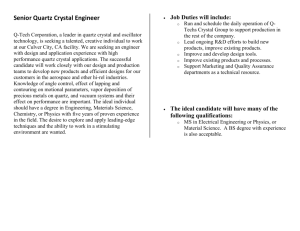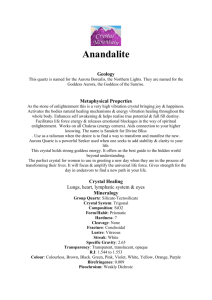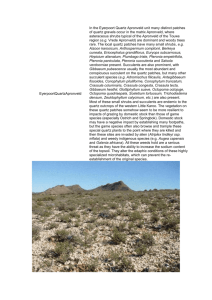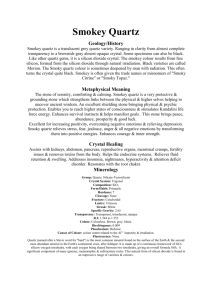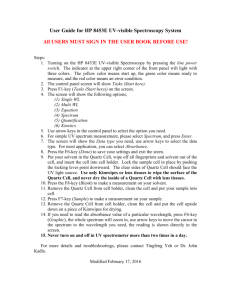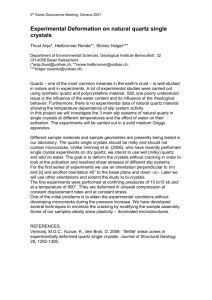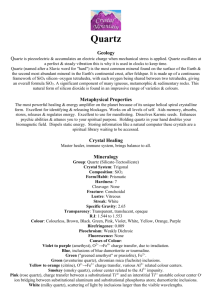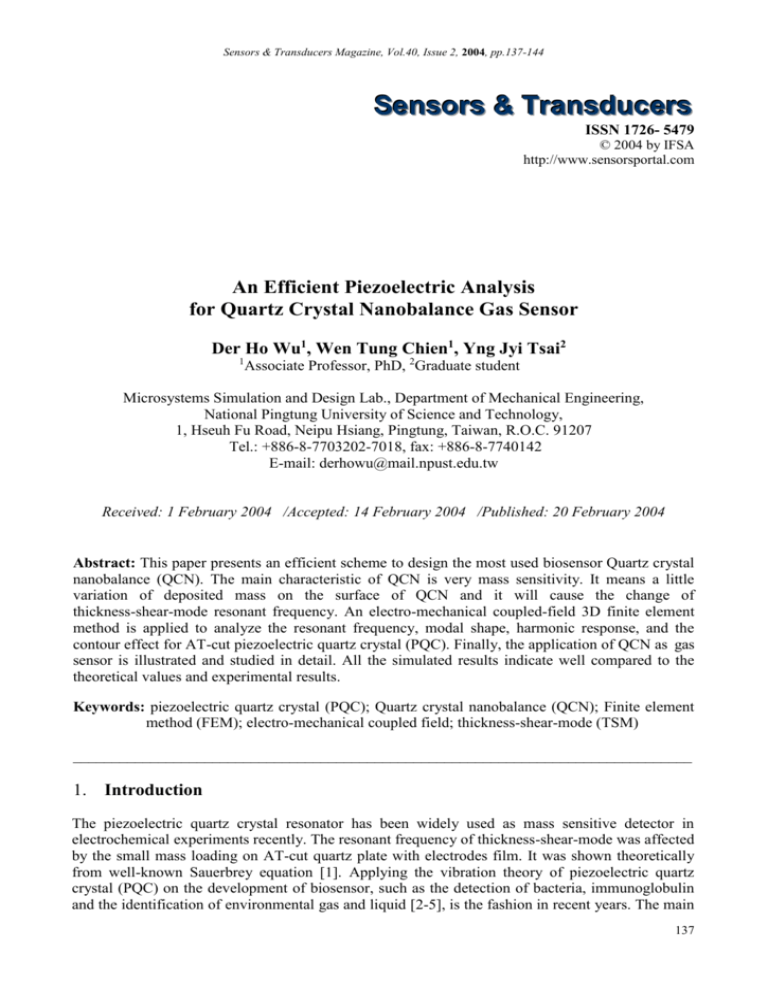
Sensors & Transducers Magazine, Vol.40, Issue 2, 2004, pp.137-144
Sensors & Transducers
ISSN 1726- 5479
© 2004 by IFSA
http://www.sensorsportal.com
An Efficient Piezoelectric Analysis
for Quartz Crystal Nanobalance Gas Sensor
Der Ho Wu1, Wen Tung Chien1, Yng Jyi Tsai2
1
Associate Professor, PhD, 2Graduate student
Microsystems Simulation and Design Lab., Department of Mechanical Engineering,
National Pingtung University of Science and Technology,
1, Hseuh Fu Road, Neipu Hsiang, Pingtung, Taiwan, R.O.C. 91207
Tel.: +886-8-7703202-7018, fax: +886-8-7740142
E-mail: derhowu@mail.npust.edu.tw
Received: 1 February 2004 /Accepted: 14 February 2004 /Published: 20 February 2004
Abstract: This paper presents an efficient scheme to design the most used biosensor Quartz crystal
nanobalance (QCN). The main characteristic of QCN is very mass sensitivity. It means a little
variation of deposited mass on the surface of QCN and it will cause the change of
thickness-shear-mode resonant frequency. An electro-mechanical coupled-field 3D finite element
method is applied to analyze the resonant frequency, modal shape, harmonic response, and the
contour effect for AT-cut piezoelectric quartz crystal (PQC). Finally, the application of QCN as gas
sensor is illustrated and studied in detail. All the simulated results indicate well compared to the
theoretical values and experimental results.
Keywords: piezoelectric quartz crystal (PQC); Quartz crystal nanobalance (QCN); Finite element
method (FEM); electro-mechanical coupled field; thickness-shear-mode (TSM)
________________________________________________________________________________
1. Introduction
The piezoelectric quartz crystal resonator has been widely used as mass sensitive detector in
electrochemical experiments recently. The resonant frequency of thickness-shear-mode was affected
by the small mass loading on AT-cut quartz plate with electrodes film. It was shown theoretically
from well-known Sauerbrey equation [1]. Applying the vibration theory of piezoelectric quartz
crystal (PQC) on the development of biosensor, such as the detection of bacteria, immunoglobulin
and the identification of environmental gas and liquid [2-5], is the fashion in recent years. The main
137
Sensors & Transducers Magazine, Vol.40, Issue 2, 2004, pp.137-144
reason is PQC has high sensitivity for the variation of mass. About the piezoelectricity of PQC is an
alternating electrical field applied perpendicular to its surface results in the generation of mechanical
vibrations [6]. In dependence on the physical characteristic of mechanical vibration, different devices
of PQC biosensor can be distinguished: surface acoustic wave (SAW), thickness shear mode (TSM),
flexural plate wave (FPW) and acoustic plate mode (APM) devices. Compared to TSM devices,
SAW, FPW and APM devices have higher mass sensitivity, but they are not suitable for the
application in liquid media because of their high damping [7]. Furthermore, among these acoustic
sensors, TSM devices have the lowest temperature dependence of resonant frequency and often used
as QCN. In this article, QCN have been investigated.
Generally speaking, QCN consists of a thin AT-cut quartz disk with metal electrodes deposited on
both sides of quartz surfaces. After deposition of different sensitive membrane on the surface of the
AT-cut quartz disk, QCN is widely applied in many fields of biochemical analysis. However, the
design and development of QCN is usually done by experiments in the past. It is hard to avoid having
error between the experimental results and true physical phenomenon of QCN because of operative
error or improper apparatus and easily results in the failure of development of QCN. Therefore,
applying 2D FEM to investigate the QCM becomes the trend of developing of products and save the
cost of design and development. From previous studies [8-9] show there are many limitations in, such
as, not easily implement and hard to construct the 3D model for general user to substitute real
experiments. Recently, the computer-aids-design provides a power simulator for MEMS [10-11]
design which able to work on the coupled field analysis, e.g. electro-mechanic, thermo-fluid by using
finite element methods. An engineer can give accurate predication about the system without no
prototype has been produced. The purpose of this article is to establish an efficient method of
designing QCN by using commercial numerical package. The effects of QCN’s resonant frequency
influenced by the variation of the thickness of electrode and deposited mass are studied and compared
with theoretical values and experimental data.
2. Transformation Matrix of AT-cut Quartz
Quartz is an oxide (SiO2) and its material coefficient changes with cutting plane from different angles
or directions. Therefore, with cutting from different angles or directions, quartz will have different
resonant frequency and vibration modes. In the design of different devices, a particular cut of the
crystal and wave propagation direction are chosen for high electromechanical coupling coefficient,
temperature stability, and low losses.
AT-cut quartz crystal is the quartz crystal that cutting from a specific rotation around the X-axis
35o15’ and the TSM shown in Fig. 1. It is suitable for the substrate of quartz crystal nanobalance
(QCN) due to its low temperature coefficient at room temperature than other kinds of quartz crystals
as Fig. 2. Numerical procedures used in determining the properties of the crystal cut require the
formulation of physical laws under coordinate transformation conditions. A very efficient
transformation matrix has been developed for consideration of the coordinate system transformations
in space of a rotation was proposed by [12-13]. Basically, it involves construction of 6 x 6 matrices
that may be used to transform stress and strain by means of a single matrix multiplication. Using the
derived transformation laws for the piezoelectric tensor for AT-cut and its transformation into the
new system of coordinates obtained the equations as follow:
[C’] = [M][C][N]-1; [e’]=[a][e][N]-1
-1
(1)
[d’] = [a][d][N] ; [ε’] = [a] [ε][a’],
138
Sensors & Transducers Magazine, Vol.40, Issue 2, 2004, pp.137-144
where the Bond stress transformation matrix are [M], [N] and [C] elasticity matrix are 6 x 6 matrices,
and piezoelectric stress [e] is a 3 x 6 matrix, [d] is the 3 x 6 piezoelectric strain matrix, [ε] is the
dielectric matrix (evaluated at constant mechanical strain), and [a] is the coordinate transformation
matrix (See Appendix I. for detail).
Y
Shear Deformation
Alternating electric field
X
electrode
Z
AT-cut quartz
Shear Deformation
Fig. 2 Geometrical model of QCN
Fig. 1 TSM vibration of AT-cut PQC
3. Quartz Crystal Nanobalance (QCN)
If applying an alternating electric field perpendicular to the surface of AT-cut quartz crystal, it will
result in shear deformation of AT-cut quartz crystal and is called as thickness shear mode. If a small
mass is deposited on the surface of AT-cut quartz crystal in air, it will result in decreasing the initial
resonant frequency of AT-cut quartz crystal. It is a very special characteristic of mechanical vibration
of QCN. The resulting frequency shift ΔFq is proportional to the deposited mass Δm. Sauerbrey [1]
derived the following equation to describe the relationship between ΔFq and Δm:
Fq 2.3 10 6 Fq
2
m
,
A
(2)
where A is the area of electrodes and Fq is the resonant frequency of TSM. It is related to its thickness
hs, shows as
Fq
1
q q
2hs
1/ 2
,
(3)
where μq and ρq are the shear modulus and the density of quartz, respectively. The relationship
between ΔFq and Δm is also called “mass loading effect”. It is the basic theory for the detection of
analyzes in air of QCN.
4. Simulations and Discussions
In this section, The finite element numerical package ANSYS is applied to study effects of QCN’s
resonant frequency influenced by the variation of the thickness of electrode and deposited mass
139
Sensors & Transducers Magazine, Vol.40, Issue 2, 2004, pp.137-144
[11,14]. The program provides a efficient tool for electromechanical coupled-field analysis and easily
implemented for engineers. All simulate results are compared with the theoretical values.
4.1 Circular AT-cut PQC: Modal and harmonic analysis
Here, a circular PQC; without electrodes, represented as 3D-solid FE model is used to verify the
accuracy of the finite element model. In the decision of element type, the coupled-field element solid
96 is chosen to simulate the AT-cut quartz. The anisotropic material properties of AT-cut quartz are
given by Append II. which obtained from Eq. (1) respectively and the dimension of FE model is given
in Table 1.
A
B
C
Fig 4. TSM of 1.87MH AT-cut PQC
Fig. 3. QCN FE model
A:mass,B:electrodes,C:quartz
A:mass,B:electrodes,C:quartz
圖三.FEA模型示意圖
Table 1. Dimension of QCN
(m)
1.87 MHz
9.5 MHz
10 MHz
50MHz
radius
0.006
0.006
.006
0.006
Thickness
0.883×10-3
1.737×10-4
1.3×10-4
3.3×10-5
Radius of
electrodes
-
-
0.004
0.004
Thickness of
electrodes
-
-
1×10-5
2×10-7
Table 2. 1.87MHz PQC resonant frequency comparison
Theoretic value
Experimental value [8]
Simulated value
1.87
1.89
1.87063
1.07
0.034
(MHz)
Error
The geometrical FE model of circular PQC used for modal and harmonic analysis were shown in Fig.
3 (A:mass,B:electrodes,C:quartz). Fig. 4 shows the plot of TSM mode shape of 1.87MHz PQC and
140
Sensors & Transducers Magazine, Vol.40, Issue 2, 2004, pp.137-144
Table 2 indicates the simulated result of TSM resonant frequency analysis compared to the theoretic
value and experimental result from [14]. Recently, the nanotechnology successfully develops a high
frequency PQC to increase the sensitivity and accuracy. The Table 3 indicates the data of the
comparisons of resonant frequency between the theoretic and simulated results. Next, a common used
9.5 MHz PQC is used for harmonic analysis and the corresponding spectrum is shown in Fig. 5 from
the FEA. The results from the simulations indicate the FE model is corrected and good for further
studies.
Fig. 5. Corresponding spectrum of the 9.5 MHz AT-cut PQC
4.2. The relation between the electrodes thickness and resonant frequency shift
The purpose of this section is to research the effect of QCN’s resonant frequency influenced by the
thickness of electrodes. Here, five different thickness of gold electrode are chosen to apply on the
surface of a 10 MHz QCN and simulate the variation of QCN’s resonant frequency. Table 3 shows the
comparison of the simulate results and theoretical values. The initial frequency is the resonant
frequency of bare AT-cut quartz, and the theoretical values are calculated by Eq. (3). Obviously, the
simulated results agree well with the theoretical values, and the errors between these two values are
less than 3%. Moreover, it indicates that the higher thickness of electrodes, the more QCN’s resonant
frequency decreases. The QCN’s resonant frequency is proportional to its thickness of electrode.
Table 3.The comparisons of different thickness of electrodes related to resonant frequency
Electrode
Resonant
Initial frequency
thickness
frequency (Hz)
(Hz)
(m)
Simulate
frequency
shift(Hz)
Simulate
Theoretical
frequency shift frequency shift
(Hz)
(Hz)
Error (%)
2×10-7
9842745.56
10012464.57
169719.01
169719.01
170200
0.283
8×10-7
9335561.46
10012464.57
676903.11
676903.11
680800
0.572
1×10-6
9151677.55
10012464.57
860787.02
860787.02
851000
1.15
4.3 The simulation of QCN as gas sensor
In this section is to study the QCN is applied as a chemical gas sensor and the effect of resonant
frequency influenced by the deposited mass is investigated. A common used 12 MHz PQC, thickness
1.3×10-4 m, is selected as the QCN quartz crystal. A 3D mass element is used to simulate the
141
Sensors & Transducers Magazine, Vol.40, Issue 2, 2004, pp.137-144
deposited mass. The simulated results show that the deposited mass is proportional to QCN’s resonant
frequency shift, i.e. the more deposited mass increase, the more QCN’s resonant frequency shift
increase. These results are the same as true physical phenomenon. Table 4 shows the simulated
results of this case. The theoretical values of resonant frequency shift are calculated by Eq. (2), and
the experimental data are obtained from [3]. Error A is the error between the simulation and
theoretical values, and error B is the error between experimental and theoretical values. Obviously,
the simulate results are more close to the theoretical values than experimental data.
Table 4 Comparisons of deposited mass and resonant frequency shift
CO2Gas
volume(L)
Mass (g)
Resonant
frequency
(Hz)
Initial
frequency
(Hz)
Simulated Theoretical Experimental
frequency frequency frequency
shift (Hz) shift (Hz) shift (Hz)[3]
2×10-9
3.5728×10-9
12760494.80
12760497.46
2.661
2.663
2.712
6×10-9
1.0718×10-8
12760489.36
12760497.46
8.100
7.989
8.223
Error(%)
A:0.069
B:1.840
A:1.392
B:2.929
A:1.217
1×10-8
1.7864×10-8
12760484.31
12760497.46
13.154
13.316
13.102
B:1.607
5. Conclusions
The purpose of this article is to establish a novel design tool for QCN by applying CAD/CAE
numerical package and some conclusions shown as follow:
(1) It is the first experience of using finite element package works on QCN study. The results show
not only generation of the structure model of QCN with ease but also simulation of QCN mass
loading with accuracy.
(2) With many advantages, such as convenience, rapidity, accuracy, low cost, easy to implement and
to learn. FEA simulator provides a new good couple-field design tool like, piezoelectric,
electro-mechanical, thermo-fluid. It is useful for biosensor and micro-actuator in MEMS study in
future.
(3) The resonant frequency shift is proportional to thickness of electrode and deposited mass and this
phenomenon is called mass loading effect and the same as real physical behavior of QCN.
Nevertheless, the comparison of simulate, theoretical and experimental data shows that the
simulate results are more close to theoretical values than experimental data.
Acknowledgements
The authors would like to thank whole members of Microsystems Simulation and Design Lab. and
financial support from Administration of Education, R.O.C.
142
Sensors & Transducers Magazine, Vol.40, Issue 2, 2004, pp.137-144
References
[1] G. Sauerbrey, Verwendung von schwingquarzen zur microwagun. Z. Phys. 155 (1959) 206-222.
[2] G.G. Guilbault, E. Prusak-Sochaczewski, J.H.T. Luong, Development f a piezoelectric immunobiosensor
for the detection of Salmonella typhimwrium, Enzyme Microb. Technol. 14 (1992) 230-235.
[3] M. Teresa S.R.,Gomes, P. Sergio, T. Nogueira, Joao A.B.P. Oliverir-a, Study on the quantification of CO2,
SO2, NH3, and H2S with a single coated piezoelectric quartz crystal, Chemical Sensors and Systems (1999)
125-128.
[4] S. Goka, K. Okabe, Y. Watanabe, H. Sekimoto, Fundamental study on multi-mode quartz crystal gas
sensors, IEEE Ultrasonics Symposium (1999) 489-492.
[5] F. Pascal-Delannoy, B. Sorli, A. Boyer, Quartz crystal microbalance (QCN) used as humidity sensor,
Sensors and Actuators A 84 (2000) 285-291.
[6] J.W. Marsen, M.C. Smit, J. Matze, The raman and infro-red spectra of some compounds, Recueil 76 (1957)
713-723.
[7] Brend Zimmermann, Ralf Lucklum, Peter Hauptmann, Jens Rabe, Stepphanus Buttgenbach, Electrical
characterisation of high frequency thickness-shear-mode resonators by impedance analysis, Sensors and
Actuators B 76 (2001) 47-5.
[8] Y-K Yong, J.T. Stewart, J. Detaint. A. Zarka, B. Capelle, and Y. Zheng, and Thickness-shear mode shapes
and mass-frequency influence surface of a circular and electroded At-cut quartz resonator, IEEE
Trans.Ultr.Ferr. and Freq. Con. 39-5, Sep.(1992).
[9]Y-K Yong, J.T. Stewart, Mass-frequency influence surface, modeshapes and frequency spectrum of a
rectangular AT-cut quartz plate, IEEE Trans.Ultr.Ferr. and Freq. Con. 38-1 Jan..(1991).
[10]O. Nagler, M. Trost, B. Hillerich, F. Kozlowski, Efficient design and optimization of MEMS by
integrating commercial simulation tools, Seneors and Actuators, A66, (1998), 15-20.
[11]Der-Ho Wu , Jeun-Wen Wu, Ming-Feng Wu, Chih-Jen Yang, 2003, Sensors & Transducers Magazine,
Vol. 38, Issue 12, December, pp.74-81.
[12]B.A. Auld, Acoustic Fields and Waves in Solids, Vol. 1, Wiley, New York, 1973, Chapter3 and 7.
[13]V.M. Ristic, Principles of Acoustic Devices, 1983, Chapter 4 and 6.
[14]ANSYS 6.0 user manual 2001.
Appendices
I. The operative matrices
M
N
1
0
0
0
0
0
0
cos 2
sin 2
sin 2
0
0
0
sin 2
sin 2
sin 2
0
0
cos 2
0
0
0
cos
sin
0
sin
cos
0
0
cos 2
sin 2
2
0
0
0
0
1
0
0
0
cos 2
sin 2
0
sin
cos
0
sin 2
sin 2
2
sin 2
2
cos 2
0
0
0
0
0
0
0
2
2
2
0
sin 2
0
0
0
0
0
0
0
0
0
cos
sin
0
sin
cos
143
Sensors & Transducers Magazine, Vol.40, Issue 2, 2004, pp.137-144
C11 C12 C13
C 22 C13
C33
C
symmetric
d 11
0
0
d
C14
0
C14
0
0
0
C 44
0
C 44
d 11
0
d 14
0
0
0
0
d 14
0
0
0
0
0
0
0
0
C14
C 66
1
0
11
0
0
0
C66= (C11-C12)/2
0
2d 11
0
0
sin
cos
0
cos
sin
a 0
22
0
0
0
33
e11
e11
0
e14
0
0
0
0
0
0
0
0
e14
0
C34
C55
e 0
0
e11
0
II. Material property of AT-cut quartz
Stiffness (109 N/m2)
C11
C12
C13
C14
C22
86.74
-8.25
27.15
-3.66
C23
C24
129.77 -7.42
5.7
C33
C56
C66
102.83 9.92 68.81 2.54 29.01
Piezoelectric Strain (10-12C/N)
d11
d12
d13
d14
d25
d26
d35
d36
-2.3
1.2181
1.0819
-2.3917
-1.7213
3.3835
1.2165
-2.3913
Piezoelectric stress (C/m2)
e11
e12
e13
e14
e25
e26
e35
e35
0.171
-0.1551
-0.0159
0.0660
0.1097
-0.0935
-0.0775
0.0661
Permittivity (10-11 F/m)
ε11
ε22
ε33
3.9843
4.0138
4.0433
Density (kg/m3) 2648
___________________
2004 Copyright ©, International Frequency Sensor Association (IFSA). All rights reserved.
(http://www.sensorsportal.com)
144

